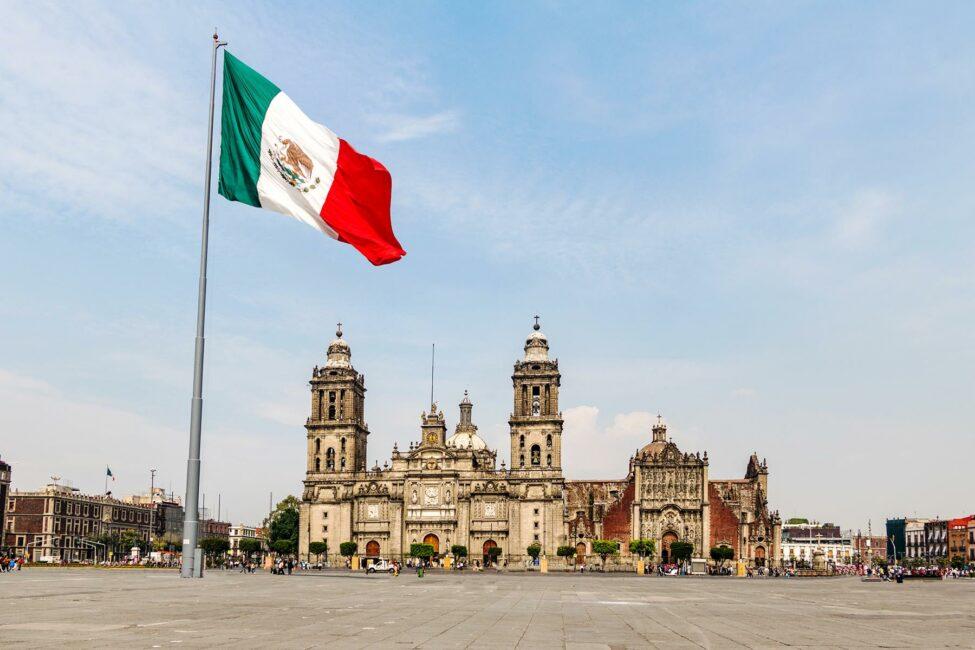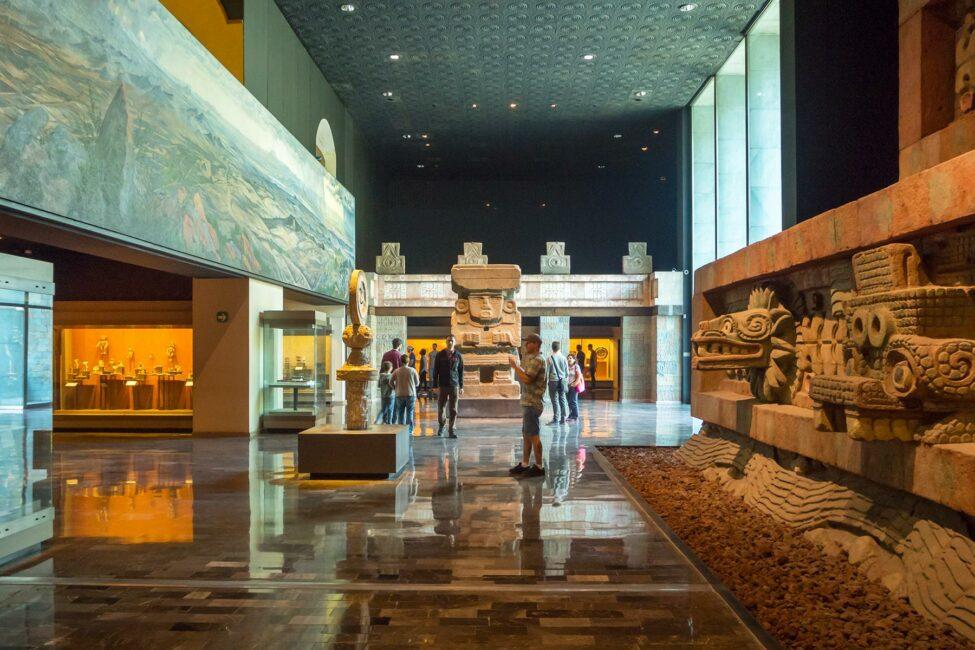Here's the best way to spend your time between flights at Latin America’s busiest airport.
Many experienced travelers call Mexico City’s airport the most confusing airport in the world. Every day, over 100,000 passengers travel through Benito Juárez International, commonly just called MEX. With Aeroméxico and value airline Interjet expanding their networks and using MEX as a hub, chances are you’ll have a layover there too. To help you avoid being one of the confused passengers, here’s what you need to know.
Entering Mexico: Papers Por Favor
MEX’s Immigration lines have been much alleviated by the mid-2018 arrival of electronic kiosks for North American passport holders. But if your connection is tight, walk briskly to the Immigration Hall, just in case.
Flight attendants should give you two forms: one for immigration (individual) and one for customs (family). If you plan to use the e-kiosk, it’s still wise to have both forms completed.
Many passengers don’t realize they’re required to fill out both the top and bottom of the immigration form—staff will check and pull you out of line if they’re not right. You’ll also need to provide the address of where you’re staying in Mexico, so have it ready.
Recommended Fodor’s Video
An immigration officer will stamp your passport and give you a slip of paper—the bottom of the paper form you filled out, or a printout if you used the kiosk. Do not lose it. You need to hand it to airline staff when boarding your flight out of the country. If you lose it, you must stand in another line to pay a 390 (approximately $20 USD) peso fine (Mexican cash only).
Getting Through Customs Quickly
Once you’ve cleared immigration, you still need to clear customs. If you’re traveling with checked bags, you must pick them up at the baggage carousel and take them through customs with you.
Put your bags—both carry-on and checked—through the x-ray machine. Go to the small kiosk and press the red button; it randomly selects you for an additional search. Green means walk on, red means follow the instructions of the officer. The officer is not allowed to press the button for you. Hand over your customs form if asked. If you’re caught with anything in excess of the baggage and duty-free allowance, such as a third camera, expect to pay duty on it.
If you have a connecting flight, look for a conveyer belt to put your checked bags on. Ask staff for instructions if your connecting flight is in the other terminal. If you’re in T1, exit through the doors to the landside of the terminal. If you’re in T2, don’t go through the doors unless you’re staying in Mexico City or transferring to Terminal 1. In T2, Security and connecting flights are up the escalator to your left.
Two Terminals and How to Travel Between Them
Most international passengers arrive at V-shaped Terminal 2 and most domestic passengers go through long and skinny Terminal 1. But there are many exceptions. You might have to change terminals for your connection. Even if staying in the same terminal, count on a long walk.
A free Aerotrén monorail connects MEX’s two terminals in seven minutes. Find it at T1 near Sala D and the Puente Pilotos Bridge, and in T2 near Gate M. You can only take carry-on luggage with you and you need to show your paper boarding pass to use it. Boarding passes on your phone aren’t good enough.
Buses also travel between terminals; most charge a small fee. If you have checked bags, you will need to take the bus or a taxi. Catch buses at Puerta 6 in Terminal 1 and Puerta 4 in Terminal 2.

Security Stations Aren’t the Same as in the U.S.
MEX has made improvements in the organization of the T2 security stations, so it runs much more smoothly than even a year ago.
In T1, there’s not as much room for multiple security stations, so lines might be long if it’s crowded. The T1 security entrance for domestic flights is on the ground floor; it’s poorly signed and it’s easy to walk past it. Ignore any signs telling you to go upstairs. Security for international flights is upstairs, with different airlines using different entrances.
Everyone goes through the same Security lines; there is no TSA PreCheck. Luckily, taking off your shoes is not a regular requirement—keep your shoes on unless told otherwise (or if you know they always set off the metal detector).
However, you will need to remove all electronics from your bag, even your phone. You’ll just waste time if you don’t do it the first time or if you ask for exceptions. Place all your electronics in one single layer in as many bins as you need. Rules for liquids are the same as in the U.S.
Brrrrr, It’s Chilly
If you’re traveling through high altitude Mexico City in the winter, dress for the airport, not your warm and sunny destination. MEX is a chilly airport, particularly overnight and in the morning hours. You’ll likely even feel a cool breeze wherever you’re waiting for your next flight. Summer and afternoons are warmer. In-the-know travelers bring a coat for the airport.
Paper Boarding Passes Are Best
Electronic boarding passes are okay for some flights, but if you have a connection, use a paper version. You’ll need a paper boarding pass if you have to change terminals and want to take the free monorail. Depending on the route you’re given upon exiting your plane in Terminal 1, a paper boarding pass can help you stay on the airside. Those with e-passes often have to exit and then go through Security again.

Where’s My Gate?
Once through security in Terminal 1, you’ll either turn left or right depending on your gate number. Be prepared for a long walk, broken up by several shops and the occasional moving sidewalk.
Terminal 2 has two poorly-signed main wings called K (to your right) and M (to your left). Gate assignments of K and M are temporary. Unless you feel like getting some airport exercise, don’t bother walking far from the central area or following staff instructions to go all the way to the seating area at the end of each wing. Your gate can easily change to the other wing, and back again. Even when a gate number shows up on a screen, the information desk staff recommend waiting for them to verify it before you take a long walk.
Where to Catch Some ZZZs
Airport lounges are ideal for long layovers but can be expensive. If you’re cutting costs but still want to have a nap to while away the hours, know that most of MEX’s seats have armrests, making it impossible to lie down. Sharp-eyed passengers will find the occasional bench without armrests and nab it for a snooze. At Gate 72, for instance, there are two such benches together, so you and a companion can each lie down with your heads and bags together. You may be able to find an area to sleep upstairs, near the lounges, but likely only on the floor. Don’t forget a jacket or shawl to help ward off the chill.
If you have an overnight layover, know that staff may ask to see your boarding pass to let you sleep in the airport. Some passengers report staff insisting they not lie down overnight.
If you want to spring for a shower and a quiet bed, there are four hotels within the airport or connected by a pedestrian bridge. T1 has a Courtyard Marriott, a Hilton and the Camino Real (shuttles take you from T2). Close to Terminal 2 is the NH Collection Hotel. T1 also has izZzleep sleep capsules, complete with TV and private bathroom, near the bus terminal.
Bring Noise Cancelling Headphones
With the chill and the few places to lie down, your chances of catching a nap are slim. It will be almost impossible unless you bring headphones. Announcements over the PA system are frequent and blaring. Your layover will be much more relaxing if you can tune them out with a podcast or some music.
INSIDER TIPDon’t rely on announcements for gate changes and departure times for delayed flights. These can change quickly and are not always announced.
Free (But Limited) Wi-Fi
MEX is improving its services. Previously, Wi-Fi was free only with an airport purchase and inputting the long password from your receipt. A 45-minute period of free Wi-Fi is now available for anyone willing to provide their email address. Once logged in, be sure to confirm your address on the link which is emailed to you, or your time may be cut short.
Note that the Wi-Fi login screen is in Spanish. You don’t need to be fluent to decipher it, it’s fairly obvious which info goes in which blank and where to click. Many Internet-related terms in Spanish aren’t too far off from the English.
Want unlimited free Wi-Fi? Use the Infinitum Novil Wi-Fi and a password provided on an airport receipt, like from Starbucks. Note that “username” in Spanish is “usario” and “password” is “contraseña.” Keep the receipt in case you’re kicked off and need to log in again.
Agua Por Favor
Mexico’s tap water isn’t potable unless you’re used to it, so you will likely need to buy water. Know that prices vary widely throughout the airport. The cheapest place to buy your agua is at one of the little pharmacies. You can get a one-liter bottle for the same price (about 20 pesos, or $1 US) as a 500-milliliter bottle at a food kiosk. Many passengers also take the opportunity to stock up on pharmaceuticals that require a prescription at home.

Where to Drink
If you want something stronger than water, MEX has several bars to choose from. Many, such as the sports bar La Taba Sport, are open 24-7.
The Starbucks near T2 Security seems to be the busiest spot to get a drink. If you’re desperate for a coffee (or an unlimited Wi-Fi password), there’s no need to stand in the line. Just keep walking toward wing M and there’s a less busy Starbucks waiting to take your money. But if you want an iced coffee, MEX Starbucks doesn’t serve them. Go to Maison Kayser instead.
Where to Eat
Food options in MEX aren’t stellar. In T1, look for Nutrisa (domestic departures, upper level) for smoothies, frozen yogurt, sandwiches, and packaged health foods. Bistrot Mosaico (international departures, lower level) serves Mexican and Mediterranean options. Alcatraz serves tacos.
In T2, Maison Kayser (K wing) has sandwiches and croissants. Taba and Salute (M wing) have Mexican fare. The upper level has a few options too.
There are food courts on the landside of both terminals, but you’ll need to go through Security again to come back to your gate. Lounges and airport hotels are other alternatives. The Courtyard Marriott’s Centro restaurant has seasonal dishes and Mexican craft beer.
A Long Layover Means the Opportunity to Explore Mexico City
If you have a layover of at least 7 hours, consider a trip into Mexico City. Be sure to sample the city’s excellent food and avoid eating at the airport. You can book a driver and guide in advance if you want to be sure to maximize your time.
To get a taxi, buy a ticket from one of the marked counters inside the airport. Ask for a sedan (pronounced “say-dan”); many travelers report being upsold to a van without their knowledge. To find your taxi, join the lineup outside for the same color ticket as you purchased.
You can also take the Metrobus (30 pesos or about $1.50 USD) or subway (5 pesos or about 25 cents USD) into the city. Avoid the 15-minute walk to the subway from T2 and just take the monorail to T1. Note the last subway car is usually designated for women only.
Leave your luggage at the Left Luggage Storage office (large bags aren’t allowed on the metro). It’s open 24 hours a day. Expect to pay about $7.50 USD per bag for a 24-hour period.




